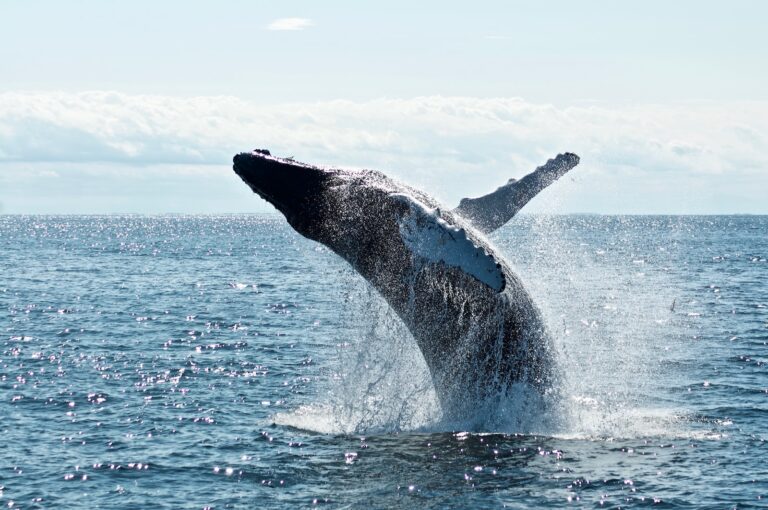Scientists are still learning about the wide world of animal penises. Often, they’re a lot larger than you might think.
The famous picture supposedly showing the Loch Ness Monster was a hoax, but other sea serpent sightings may have been mistaken for whale penises. Read on to discover some of the biggest (and weirdest) animal penises.
Blue Whale
A blue whale’s penis can be as long as a basketball court. That’s the same length as an adult human and carries enough sperm to fill up a school bus—and it’s just the tip of the iceberg when it comes to animal penises.
This massive creature is one of the loudest and largest animals on Earth, and its giant body is home to a spermaceti secretion that’s used for fertilization. Blue whales can produce as much as 330,000 pounds of sperm during their lifetime, Ocean Info reports. That’s the same amount of burgers you could consume every day for the rest of your life!
Blue whales also have a very impressive tail fin, which can be more than 25 feet wide and is used to help them push themselves through the water. And, while we’re talking about tails, it’s worth noting that an adult female blue whale can weigh as much as a midsize car.
Another animal that makes us look a bit wimpy is the barnacle, whose genitalia are nearly eight-times their body size. These hermaphrodites use their super-long penises to reach nearby crustaceans and blindly deposit sperm inside them. Interestingly, their penis features change based on the environment: in rough waters, barnacles have shorter, stout penises while in calmer areas they have longer, slender ones.
Barnacles
By their very nature, barnacles get a bad rap: they’re stuck in place, slowing boats or sticking to people like parasites. But these humble invertebrates, which spend their lives glued to rocks, piers, mussel shells, or Michael Moore’s boat propellers, have one superlative claim to fame: they’re hermaphrodites, with both male and female reproductive organs. And that hermaphroditic trait helps them maximize the chances of successfully producing the next generation, which they do by extending their long penis (proportionally the longest in the animal kingdom) to search for their neighbors’ shells with eggs in need of fertilization.
When a pair of neighboring barnacles find each other, they’ll extend their male appendage over to one another and deposit sperm in an empty shell cavity. Then, when the water temperature is right and the season is in full swing, the paired barnacles will develop into minuscule alien-looking creatures with feathery wings and two short antennas, ready to swim off into their own marine life.
As for the phallus of blue whales, it’s proportionally the largest in the animal kingdom at eight to ten feet long with a foot-long diameter. But that’s nothing compared to the penises of some other animals: the leopard slug (Cromodoris reticulata) has two spined single-use penises, each a whopping three inches in length; if these creatures were the same size as a blue whale, their combined length would equal that of the whale’s body.
Dolphins
Dolphins are mammals that live in the ocean and belong to the whale family. There are about 40 different species of dolphins, ranging in size, weight and behaviour. They can be white, pearl-colored, rose, brown, grey or blue and can reach a length of 12 to 18 feet (3.6 to 5.4 meters). The largest dolphin is the orca, better known as a killer whale.
A female orca can weigh up to 22,000 pounds, while males can grow to be 32 feet (10 meters) long. Their long penises play a key role in mating, reaching down to blindly deposit sperm into crustaceans. When not erect, the penis sits within their body, emerging from a preputial sac for use and retracting back into it when not needed.
Like barnacles, their penises are influenced by the environment they live in: calm waters produce long and slender penises, while rough water leads to short and stout ones. They can also move their penises around to adjust them for different environments, a flexibility that is likely important in the process of finding a good mate.
Interestingly, researchers have debunked a popular theory that the Loch Ness Monster is actually a large whale penis. In April, molecular ecologist Michael Sweet tweeted photos of a dried tip of a blue whale penis, along with an alleged picture of the legendary sea serpent and captioned them to highlight their remarkable similarity.
Right Whale
Right Whales (Eubalanea wrighti) are one of the largest baleen whale species. Adult males can grow to nearly 60 feet in length and weigh almost 300,000 pounds! Their penises are often retracted but can become exposed when agitated. This is why the naive sailors of long ago probably mistook them for serpent-like tails when they encountered these large animals!
The whale’s penis is actually a pair of fused structures attached to a vestigial pelvic bone. They are very agile and can change shape to fit the female they are mating with. This is one of the reasons why they are able to ejaculate so much semen. Each of the testicles can weigh up to a hundred and fifty pounds!
Unlike other whales, right whales typically breed with a single female. The male will touch the female’s belly with his prehensile penis to court her and then penetrate her to inseminate her. Several males may try to mate with a single female and the most dominant male will win out in the end.
During breeding, right whales can be observed nuzzling each other and rolling around while exposing their flippers, flukes, heads, and bellies. These displays are meant to show their dominance and aggressiveness to potential mates. This behavior is also believed to help the male wash another whale’s sperm off the female to improve their chances of fertilizing her eggs.
See Also:



